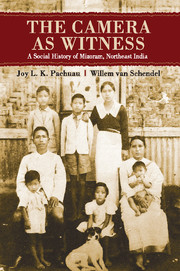Book contents
- Frontmatter
- Contents
- List of Figures
- List of Maps
- Acknowledgements
- I Becoming Mizo
- II Mizoram in the New India
- 11 The Long Goodbye
- 12 The Emergence of Popular Politics
- 13 Mizoram and the New Indian Order
- 14 Mizoram Comes to Delhi
- 15 The Search for Authenticity at Home
- 16 Mizo Style: Cowboys at Heart
- III Visions of Independence
- IV Mizo Modernities
- Copyrights and Sources
- Glossary
- Bibliography
- Index
16 - Mizo Style: Cowboys at Heart
from II - Mizoram in the New India
Published online by Cambridge University Press: 05 May 2015
- Frontmatter
- Contents
- List of Figures
- List of Maps
- Acknowledgements
- I Becoming Mizo
- II Mizoram in the New India
- 11 The Long Goodbye
- 12 The Emergence of Popular Politics
- 13 Mizoram and the New Indian Order
- 14 Mizoram Comes to Delhi
- 15 The Search for Authenticity at Home
- 16 Mizo Style: Cowboys at Heart
- III Visions of Independence
- IV Mizo Modernities
- Copyrights and Sources
- Glossary
- Bibliography
- Index
Summary
As we have seen, after Independence, the Indian state elite developed a policy that designated Mizoram a ‘tribal’ area. This prompted the inhabitants to construct modern ‘tribal’ identities out of selected traditional cultural elements (Chapters 14 and 15). But these were not the only new identities that developed. The photographs in our collection show clearly that there was another trend as well. Following Duncan McDuie-Ra, we can describe it as cosmopolitan modernism. Its roots were older than those of the neo-traditionalist ‘tribal’ identities.
Mizoram's short but intense brush with colonial rule and western-type education had produced an early awareness among the educated of a range of global identities – and a strong desire to explore these (Chapter 3). Young educated Mizos presented themselves to the camera in fashionable outfits that were intended to convey a certain ‘global chic’. In Figure 16.1, we see young Mizo men in such outfits in the 1920s, a mere 30 years after the colonial conquest. The photograph exudes global modernity: the clothes, the arrangement of the group, the chairs on which they sit – none of these has a ‘traditional’ Mizo referent. What makes this photograph especially interesting is that it not only shows these young men to have been sartorially savvy but also that they appear to have been totally unaffected by the Indian nationalist fashion of the day, which prescribed locally made, homespun clothes in indigenous styles as a sign of resistance against British rule.
This interest in cosmopolitan modernism received a further boost in the Second World War when Allied Forces spread across Mizoram. Mizos keenly observed these newcomers and tuned in to their lifestyle. Mizos who had joined the army were in even closer contact, and it is in this period that a fascination with a theme from the American West, the cowboy, appears to have taken root. Young Mizo men began to adopt cowboy-inspired dress styles and they discovered the guitar and American popular music (Figures 16.2–16.4; see also Figures 3.7–3.9).
- Type
- Chapter
- Information
- The Camera as WitnessA Social History of Mizoram, Northeast India, pp. 288 - 294Publisher: Cambridge University PressPrint publication year: 2015

